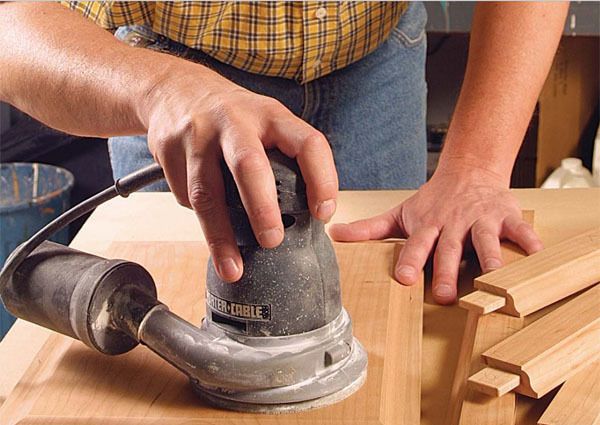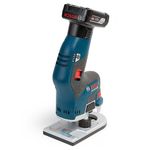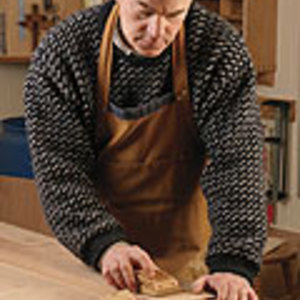All About Sanders

Sanders come in as many varieties as any tool in the shop, from detail sanders that can reach into corners or smooth molding profiles to heavy belt sanders that quickly grind down uneven edges and flatten rough panels to stationary drum sanders. Most woodshops will end up with at least a few of these tools.
What Counts:
• Variable speed
• Efficient dust collection
• Size and weight
• Choice of abrasives
• Ease of changing abrasives
Detail sanders
Detail sanders come in two basic types, those with an oscillating head and a triangular sanding pad, and in-line sanders with a back-and-forth motion better suited to profiled edges. Oscillating sanders can reach into tight spots where no other type of sander would work — the corner of a drawer, for example. The most expensive models offer extensive accessories, including grout removers, scrapers, and saw blades. Profile sanders are available with a variety of heads that can be matched to a curved or profiled surfaces. Hook-and-loop and pressure-sensitive adhesive abrasives are available.
Orbital sanders
For finishing work, orbital sanders are relatively gentle machines that don’t remove material too quickly. The base of the machine makes a simple 1/16-in. to 1/8-in. orbit. Bases are rectangular in shape and accept either 1/4 or 1/2 of a sheet of sandpaper, either with a hook-and-loop or PSA backings or simply by using a couple of metal clamps with standard abrasives. Because of the shape of the base, these sanders can get close to an inside corner. On the downside, the orbital action can leave pigtail-shaped scratches in the surface of the wood that are especially obvious with coarser grits of paper.
Random-orbit sanders
Random-orbit sanders are designed to make a smoother sanding pattern by combining an orbital and spinning motion. This double-action base makes random-orbit sanders more aggressive than conventional orbital machines while minimizing swirl marks. Some models come with variable-speed options, allowing the sander to be used less aggressively. Small random-orbits, often called palm sanders, usually have 5-in.-dia. bases with eight holes to aid dust collection. Larger and heavier random-orbits have 5-in. or 6-in. bases and may have an adjustable orbit. Right-angle random-orbits are larger yet. With more powerful motors, these sanders are often used two-handed and can be nearly as aggressive as a belt sander. One important feature for these sanders is pad dampening, which prevents the pad from spinning at top speed when the sander is lifted from the work.
Belt sanders
Belt sanders also come in a variety of sizes, but the most common have belts ranging from 3 in. by 21in. to 4 in. by 24 in. There are two basic types: transverse machines, with motors mounted perpendicular to the belt, and the more compact in-line machines, with motors mounted in the center of the tool. Larger belt sanders can remove a great deal of material and are useful for sanding large surfaces. Many models offer an accessory sanding frame that helps prevent gouging, and some are available with variable-speed controls.
Drum sanders
For small woodworking shops, a drum sander made by one of a half-dozen manufacturers is a lower-priced alternative to the wide-belt sanders found in big production shops. While some of these machines are heavy floor models, they are smaller in size than their wide-belt cousins and range in cost from less than $600 to about $2,500.
These sanders are capable of dimensioning stock with coarse-grit papers, smoothing stock up to 36 in. wide and removing cup from the face of a board. Instead of using wide abrasive belts, this group of sanders uses an abrasive strip that is wound around a drum, hence the name. They can handle grits from 36, for dimensioning stock, all the way up to 220, for fine finish sanding.
Open frame vs. closed frame
Machines come in two styles. Cantilevered (open-sided) drum sanders can handle stock twice the width of their sanding drums. They come with smaller motors — in the 1-hp to 1-1/2-hp range — cost less and are lighter the closed-frame sanders. To sand a panel wider than the drum width, the operator must adjust the table-to-drum alignment, a process that takes a couple of minutes. One model on the market has a two-speed drum whose lower speed is better suited for heavy stock removal. The ease of changing the abrasive strip varies by machine.
Closed-frame machines are larger and more powerful, better suited to the demands of regular use. These sanders range in price from about $1,100 to $2,400. Motors are rated up to 5 hp, and the machines weight at least several hundred pounds — one model is about 650 lb. Despite the weight, some manufacturers offer mobile bases so the sanders can be moved around the shop. As with the cantilevered sanders, changing abrasive belts can be anything from very easy to awkward. One model offers a double-drum system that can accommodate two grits of sandpaper.
Fine Woodworking Recommended Products

Festool DF 500 Q-Set Domino Joiner

Milwaukee M12 23-Gauge Cordless Pin Nailer

Bosch 12V Trim Router





















Log in or create an account to post a comment.
Sign up Log in